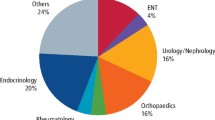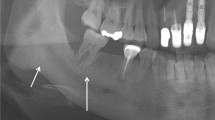Abstract
Data sources
Cochrane Oral Health Group Trials Register, CENTRAL, Medline, Embase, CancerLit, CINAHL, AMED, clinicaltrials.gov and the WHO International Trial Registry Platform. The reviewers searched six grey literature sites and contacted authors, researchers and pharmaceutical companies.
Study selection
Randomised controlled trials for the treatment of BRONJ comparing interventions with other treatment or placebo were included in any setting with no age restriction.
Data extraction and synthesis
Independently, two reviewers selected studies for inclusion, risk of bias and data extraction. The main outcome was healing. Secondary outcomes were pain improvement and quality of life.
Results
One RCT with 49 patients met the inclusion criteria comparing the addition of hyperbaric oxygen therapy to standard of care alone. Changes in the lesion size and number were assessed at 3, 6, 12 and 18 months. Pain was assessed weekly while quality of life was assessed at baseline and six months. Improvement, as measured by the decrease in the size or number of lesions, achieved a RR 1.94, CI 95% (1.01 to 3.74) at three months. No other measure of this outcome was statistically significant. Pain changes and quality of life could not be numerically analysed.
Conclusions
The authors concluded that there is insufficient evidence to support a particular regimen for the treatment of BRONJ.
Similar content being viewed by others
Commentary
Despite a comprehensive review of multiple resources on the search for published and unpublished studies until 2015 with no language, age or setting restrictions, the authors identified two ongoing trials and 13 studies with comparison groups. Twelve were later excluded because of the lack of randomisation. This well planned review reports on a single study with 49 participants comparing the addition of hyperbaric oxygen therapy to the ‘standard care’. The patients had been treated with bisphosphonates for different conditions and followed up for up to 24 months.
The study was assessed as having high bias risk for performance and detection, attrition and other potential sources of bias. Fifty percent of patients were lost to follow-up by 12 months and an even smaller percentage was available by 18 months. Five patients crossed from control group to the treatment group and one from the treatment to the control group. Data analysis was performed based on treatment allocation.
Healing was assessed as changes in lesion size and number, considering four possible outcomes: healed, improved, unchanged and worse. The only statistically significant result was for improvement at three months. The authors provide a very comprehensive list of recommendations for future research and describe in detail the knowledge gaps still present with the three currently used interventions: conservative, surgical and adjuvants.
While this review concentrates on BRONJ (bisphosphonate-related osteonecrosis of the jaw) other medications are linked to osteonecrosis of the jaw, including the new category of anti-resorptive medications: RANK-Ligand inhibitors (denosumab) and novel anti-cancer drugs targeting angiogenesis. As a result the more inclusive term MRONJ (medication-related osteonecrosis of the jaw) has been adopted.1
The prevalence of the condition seems to be very low, but among the known risk factors, tooth extraction and wearing dentures significantly increase the risk for developing ONJ in cancer patients.2
It is unlikely that even the best planned RCT study will be able to address most of the recommendations listed by the authors and also have enough participants with such a low prevalence condition. In addition, the variability present in what is considered the standard for conservative interventions, surgical techniques and adjuvants treatments adds to the challenge. The 2017 publication ‘Case-Based Review of Osteonecrosis of the Jaw (ONJ) and Application of the International Recommendations for Management from the International Task Force on ONJ’3 can help provide more concrete guidance on the topic.
References
American Association of Oral and Maxillofacial Surgeons. AAOMS position paper renames and expands the scope of Bisphosphonate Related Osteonecrosis of the Jaw — now Medication Related Osteonecrosis of the Jaw (MRONJ). 2014. Available at http://www.aaoms.org/news/aaoms-position-paper-renames-and-expands-the-scope-of-bisphosphonate-relate (accessed May 2017).
American Association of Oral and Maxillofacial Surgeons. Medication-Related Osteonecrosis of the Jaw—2014 Update. 2014. Available at http://www.aaoms.org/docs/govt_affairs/advocacy_white_papers/mronj_position_paper.pdf (accessed May 2017).
Khan AA, Morrison A, Kendler DL, et al International Task Force on Osteonecrosis of the Jaw. Case-Based Review of Osteonecrosis of the Jaw (ONJ) and Application of the International Recommendations for Management From the International Task Force on ONJ. J Clin Densitom 2017 20: 8–24.
Author information
Authors and Affiliations
Additional information
Address for correspondence: Luisa Fernandez Mauleffinch, Managing Editor, Cochrane Oral Health Group, School of Dentistry, The University of Manchester, JR Moore Building, Oxford Road, Manchester, M13 9PL, UK. E-mail: luisa.fernandez@manchester.ac.uk
Rollason V, Laverrière A, MacDonald LC, Walsh T, Tramèr MR, Vogt-Ferrier NB. Interventions for treating bisphosphonate-related osteonecrosis of the jaw (BRONJ). Cochrane Database Syst Rev 2016; 2: CD008455.
This paper is based on a Cochrane Review published in the Cochrane Library 2016, issue 2 (see www.thecochranelibrary.com for information). Cochrane Reviews are regularly updated as new evidence emerges and in response to feedback, and the Cochrane Library should be consulted for the most recent version of the review.
Rights and permissions
About this article
Cite this article
Spivakovsky, S. Treatment for bisphosphonate-related osteonecrosis of the jaw. Evid Based Dent 18, 56 (2017). https://doi.org/10.1038/sj.ebd.6401243
Published:
Issue Date:
DOI: https://doi.org/10.1038/sj.ebd.6401243



